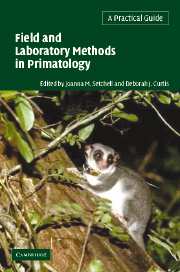Book contents
- Frontmatter
- Contents
- List of contributors
- Forword by Robert D. Martin
- Introduction
- 1 Human-nonhuman primate interactions: an ethnoprimatological approach
- 2 Habituating primates: processes, techniques, variables and ethics
- 3 Habitat description and phenology
- 4 The Global Positioning System, Geographical Information Systems and Remote Sensing
- 5 Monitoring local weather and climate
- 6 Survey and census methods: population distribution and density
- 7 Trapping primates
- 8 Handling, anaesthesia, health evaluation and biological sampling
- 9 Morphology, morphometrics and taxonomy
- 10 Marking and radio-tracking primates
- 11 Feeding ecology and seed dispersal
- 12 Dietary analysis I: Food physics
- 13 Dietary analysis II: Food chemistry
- 14 Collecting arthropods and arthropod remains for primate studies
- 15 Tape-recording primate vocalisations
- 16 Photography and video for field researchers
- 17 Chronobiological aspects of primate research
- 18 Thermoregulation and energetics
- 19 Field endocrinology: monitoring hormonal changes in free-ranging primates
- 20 Collection, storage and analysis of non-invasive genetic material in primate biology
- 21 Tips from the bush: an A-Z of suggestions for successful fieldwork
- Index
- References
4 - The Global Positioning System, Geographical Information Systems and Remote Sensing
Published online by Cambridge University Press: 05 June 2012
- Frontmatter
- Contents
- List of contributors
- Forword by Robert D. Martin
- Introduction
- 1 Human-nonhuman primate interactions: an ethnoprimatological approach
- 2 Habituating primates: processes, techniques, variables and ethics
- 3 Habitat description and phenology
- 4 The Global Positioning System, Geographical Information Systems and Remote Sensing
- 5 Monitoring local weather and climate
- 6 Survey and census methods: population distribution and density
- 7 Trapping primates
- 8 Handling, anaesthesia, health evaluation and biological sampling
- 9 Morphology, morphometrics and taxonomy
- 10 Marking and radio-tracking primates
- 11 Feeding ecology and seed dispersal
- 12 Dietary analysis I: Food physics
- 13 Dietary analysis II: Food chemistry
- 14 Collecting arthropods and arthropod remains for primate studies
- 15 Tape-recording primate vocalisations
- 16 Photography and video for field researchers
- 17 Chronobiological aspects of primate research
- 18 Thermoregulation and energetics
- 19 Field endocrinology: monitoring hormonal changes in free-ranging primates
- 20 Collection, storage and analysis of non-invasive genetic material in primate biology
- 21 Tips from the bush: an A-Z of suggestions for successful fieldwork
- Index
- References
Summary
INTRODUCTION
Geographical Information Systems (GIS) and the Global Positioning System (GPS) are powerful tools that enable ecologists to acquire, store, analyse and display spatial ecological data (Dominy & Duncan, 2001), whereas remote sensing can provide information unobtainable by traditional methods. Although there has been an exponential rise in the use of this technology-based synergism for spatial analyses, mapping and modelling in the ecological and plant sciences (Du Puy & Moat, 1998; Dale, 1999; Wadsworth & Treweek, 1999), there have been few, fully integrative applications by primatologists (but see Table 4.1). Applications relevant to primatologists include: vegetation classification and mapping; forest fragmentation assessment; biomass estimation; population viability analyses; animal censusing; habitat sensitivity/vulnerability mapping and analysis; location and delimitation of protected areas; radio-tracking/foraging patterns and cost–distance analyses; and nesting pattern analysis.
In remote areas, where species and habitat information is limited, predictive modelling within a GIS can be a useful precursor to fieldwork (Lenton et al., 2000), and integrating remotely sensed imagery can enhance such models. This is particularly useful in areas such as Central Africa where political instability and boundary conflicts may significantly influence fieldwork decisions: satellite sensors can safely gather data across national boundaries. The use of remotely sensed imagery is particularly appropriate if suitable maps are not available.
Information
- Type
- Chapter
- Information
- Field and Laboratory Methods in PrimatologyA Practical Guide, pp. 57 - 73Publisher: Cambridge University PressPrint publication year: 2003
References
Accessibility standard: Unknown
Why this information is here
This section outlines the accessibility features of this content - including support for screen readers, full keyboard navigation and high-contrast display options. This may not be relevant for you.Accessibility Information
- 1
- Cited by
